Salish speakers gather
Tribes hope to save disappearing dialects

It wasn’t until 11 Kalispel elders died within three months a few years ago that the tribe realized the urgency of its mission to preserve its Salish dialect, a tribal elder said Thursday.
“It is said if we lose our language we are not going to be a tribe anymore,” said Francis Cullooyah, one of more than 64 speakers of Southern Interior Salish, including 30 elders, gathered from several tribes for a two-day language summit at Spokane Falls Community College.
No one can remember a gathering of so many speakers of the first language of the Inland Northwest, said Michelle Wiley-Bunting, board president of the Center for Interior Salish.
The center’s task is daunting, she said, because few fluent speakers are left of the language once heard from Vernon, B.C., to Vantage, Wash., and from Wenatchee to the Bitterroot Valley in Montana.
“Our elders taught us that we are like brothers because of our language,” said Coeur d’Alene elder Felix Aripa.
He spoke in English and Coeur d’Alene, one of seven dialects of Southern Interior Salish spoken Wednesday. Also attending were fluent speakers of Kalispel, Spokane, Colville Okanogan, Wenatchee-Columbian, Pend Oreille and Montana Salish.
Not represented at the conference were speakers of the three Northern Interior Salish dialects – Shuswap, Thompson and Lillooet – all in Canada.
“Our language is our culture,” Aripa said. “It is how we learned about our animals, our plants and our mountains. And that’s what, through the language, we want to teach our kids.”
Cullooyah said Kalispel is taught at Cusick, Wash., schools, and the tribe is transcribing the spoken language using the International Phonetic Alphabet.
He said only he and two other people are fluent in Kalispel.
There are believed to be two fluent speakers of Coeur d’Alene, six who speak Spokane and five who speak Wenatchee-Columbian, according to the Center for Interior Salish. There are about 200 fluent speakers of Colville-Okanagan, three-quarters of whom live on the Canadian side of the border that now splits their historic lands.
About 110 people were expected to attend the language summit, which continues today at the SFCC Student Union Building. The conference includes workshops in which participants can share ways to teach and preserve one of the most endangered languages in the world.